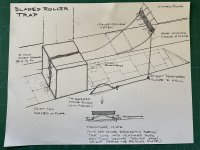Imaculata
Hero
I had a nasty trap in one of my dungeons, where a pressure plate hidden on one of the steps of a descending staircase, triggers two sharp blades.
As soon as someone steps on the trigger, a blade swings sideways from the stairs, into the ankles of the victim. Meanwhile a second blade unfolds at neck level, and swings at the victim from the front, with the intent of beheading them.
Pc's can spot a small horizontal shaft in the wall, where the 2nd blade comes out, if they look for it. They may also spot some minor blood remains at the bottom of the stairs. The 1st blade in the stairs however, is hidden completely from view when descending the stairs.
As soon as someone steps on the trigger, a blade swings sideways from the stairs, into the ankles of the victim. Meanwhile a second blade unfolds at neck level, and swings at the victim from the front, with the intent of beheading them.
Pc's can spot a small horizontal shaft in the wall, where the 2nd blade comes out, if they look for it. They may also spot some minor blood remains at the bottom of the stairs. The 1st blade in the stairs however, is hidden completely from view when descending the stairs.



